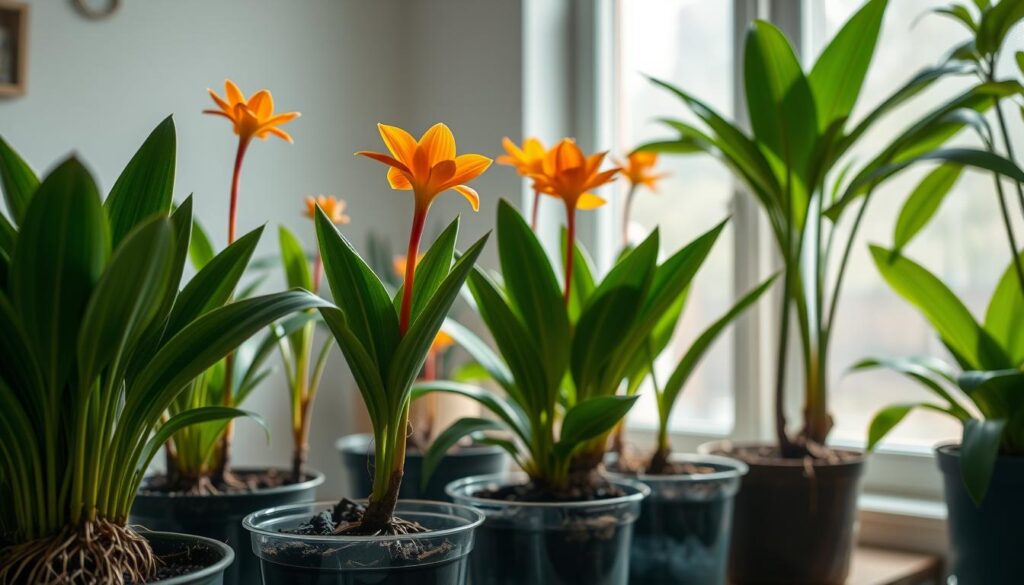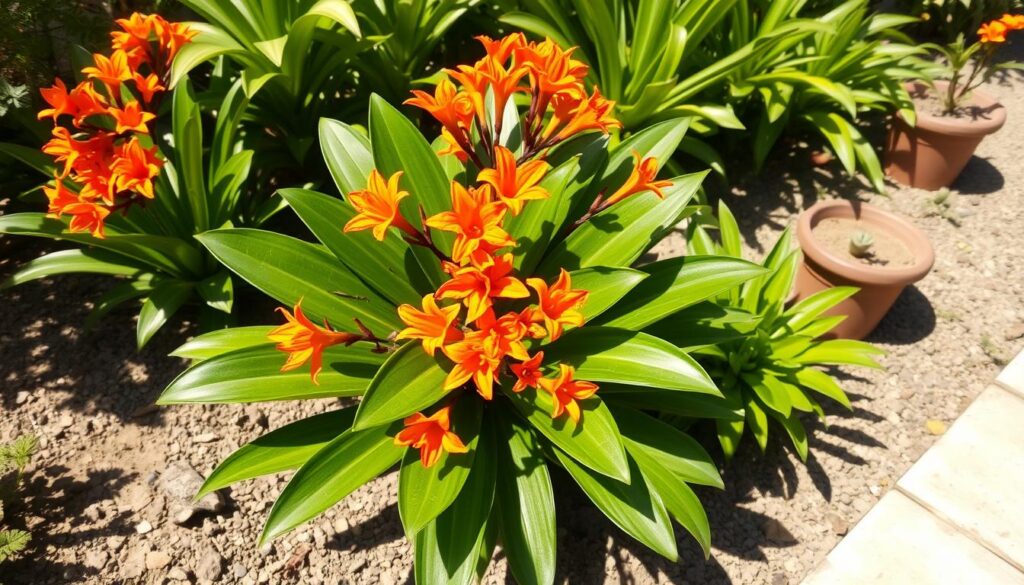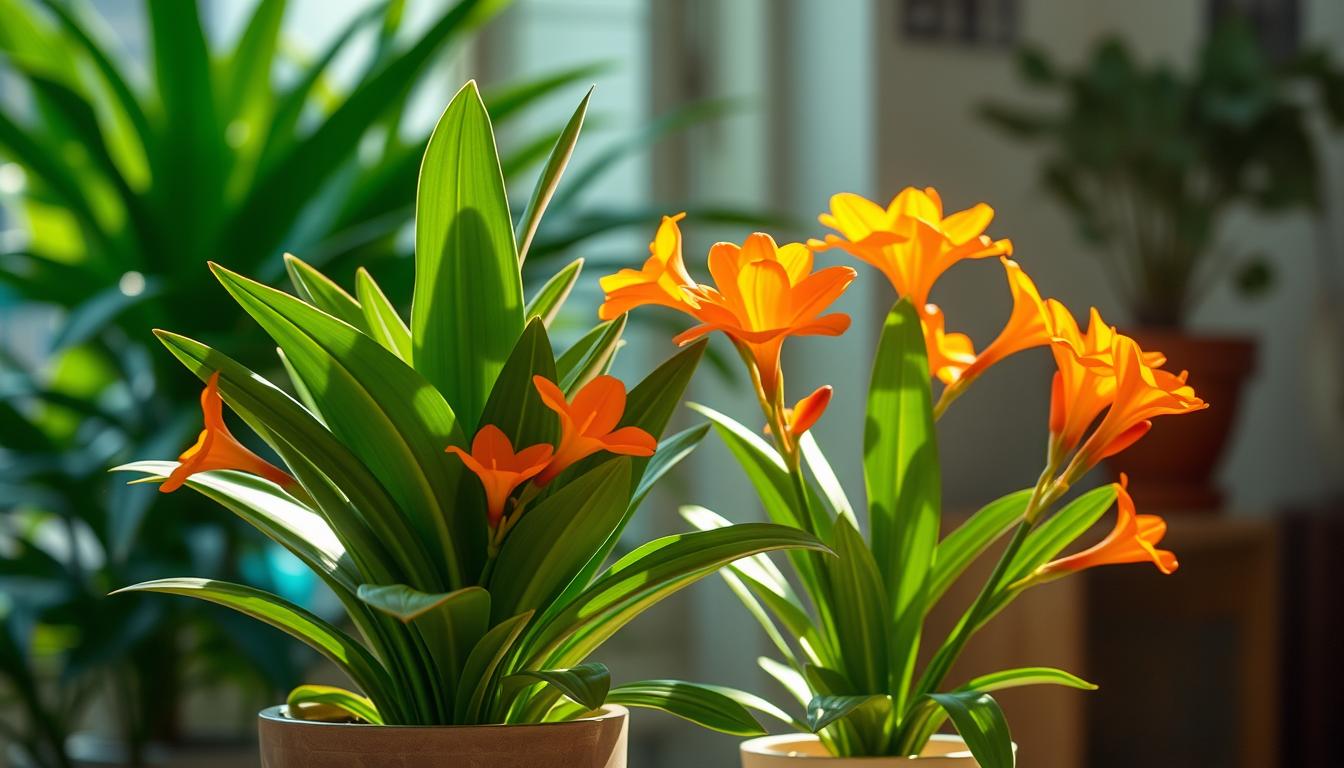Introducing the Magnificent Clivia Plant
Exploring Clivia plants reveals their rich history and special traits. They come from South Africa and are loved for their Clivia flowers and green leaves. With the right Clivia care, you can bring these beauties into your space. Clivia plants come in many colors like yellow, orange, and pink. Breeders have worked hard to create these colors. You can find the perfect Clivia plant for your garden or home. The Clivia miniata ‘Longwood Chimes’ is a rare red-flowered variety. It’s very sought after. This shows why Clivia flowers are loved by many.Origin and Natural Habitat
Clivia plants come from South Africa’s woodlands. They love shaded spots, making them great for indoors or shady gardens.Key Features and Characteristics
Clivia plants have long-lasting Clivia flowers and nice leaves. With good care, they bloom for weeks, adding beauty to your space.Why Choose Clivia for Your Home
Clivia plants are easy to care for and look amazing. They’re perfect for adding elegance or enjoying nature’s beauty at home.Essential Growing Requirements for Your Clivia
To make your Clivia indoor plant happy, give it the right home. It needs a spot that’s warm and light, but not too sunny. Clivia care means knowing it likes soil that drains well and needs water, especially in winter. Knowing about Clivia maintenance is important. The plant’s sap can make your skin itch. Eating any part can upset your stomach a bit. So, knowing what your Clivia needs helps it grow well. Here are some important tips for Clivia care:- Water your Clivia plant regularly, but sparingly, especially during the winter months.
- Provide good light, but avoid direct sunlight.
- Use well-draining soil to prevent root rot.
- Fertilize your Clivia plant monthly during the growing season with a half-strength fertilizer solution.
Understanding Light and Temperature Needs
Clivia care needs the right light and temperature. Your Clivia should get partial to full shade. This keeps it from getting too hot and scorching its leaves. Clivia plants like cooler temperatures in winter and warmer in summer. Keep it away from frost to avoid stress. Watch the temperature closely to keep your Clivia healthy.Optimal Lighting Conditions
Clivia plants like average humidity but enjoy misting when it’s dry. Place it near an east- or west-facing window for filtered light. This helps it grow well without scorching its leaves.Temperature Range for Healthy Growth
Don’t put your Clivia near heating vents or drafty windows. The right temperature and light are key to caring for your Clivia. This way, you’ll enjoy its beauty all year.Seasonal Care Adjustments
Change your Clivia care with the seasons. Water less in winter to avoid root rot. Use mulch to keep the roots warm. With proper care, your Clivia will thrive all year, indoors or outdoors.Soil, Water, and Feeding Guidelines
For Clivia care, the right soil, water, and food are key. A mix that drains well is crucial to avoid root rot. Learn more about making a good potting mix at trusted houseplant guides. Water your Clivia often in summer but less in winter. Let the soil dry a bit between waterings. Here are some tips:- Water your Clivia when the top inch of soil feels dry
- Reduce watering during the dormant winter period
- Fertilize with a balanced fertilizer during the growing season to promote healthy growth and flowering
| Season | Watering | Fertilization |
|---|---|---|
| Summer | Regular, moderate watering | Balanced fertilizer |
| Winter | Reduced watering | No fertilization |
Common Varieties of Clivia for Indoor and Outdoor Growth
Exploring Clivia plants, you’ll find many Clivia varieties. They grow well indoors and outdoors. With over six species, like Clivia miniata and Clivia nobilis, you can pick the right plant for your space. Indoor favorites, C. miniata and C. nobilis, have bright Clivia flowers and nice leaves. Outdoors, Clivia plants like shaded spots with good drainage. They’re great for gardens and patios.Popular Indoor Varieties
- C. miniata: A popular species with bright orange Clivia flowers
- C. nobilis: A species with white or yellow Clivia flowers and attractive foliage
Mastering Clivia Propagation Methods
Exploring Clivia care opens up a world of sharing and creating. You can give plants to loved ones or grow new ones. Clivia care means giving your plants the best home. Propagation is key to their growth. Division is a common way to grow Clivias. It means taking offsets from the main plant and growing them on their own. This can be done all year. But, make sure the offsets have roots and are handled gently. Seed propagation is another way. It takes a few years for the plants to bloom. Learning these methods lets you control your plants’ quality and create new ones. Propagation with Clivias needs patience and care. Clivia plants are delicate. Rough handling can hurt their roots or leaves. Give them bright, indirect light and well-draining soil for the best chance of success. Here are some tips for Clivia propagation:- Use a well-draining potting mix to prevent waterlogged soil
- Provide bright, indirect sunlight to promote healthy growth
- Water carefully, avoiding overwatering, which can lead to root rot
- Fertilize regularly, using a balanced fertilizer to promote healthy growth and flowering
 By following these tips, you can master Clivia propagation. This lets you share your plants and grow new ones. Enjoy the many benefits of caring for Clivias.
By following these tips, you can master Clivia propagation. This lets you share your plants and grow new ones. Enjoy the many benefits of caring for Clivias.
Troubleshooting Common Clivia Problems
When you take care of your Clivia plants, you might face some common issues. Pests like mealybugs, aphids, and red spider mites can harm your plants. They can damage the leaves and flowers. To avoid pests, make sure to check your plants often. Give them the right growing conditions. Use a good potting mix, water carefully, and fertilize regularly. This helps keep your Clivia plants healthy and strong. Problems like yellow leaves, slow growth, and root rot can happen. Fix these by changing the plant’s environment. Adjust the light, temperature, and how much you water. Knowing these issues and how to prevent them helps your Clivia plants stay healthy. You’ll also enjoy their beautiful flowers.Seasonal Care and Maintenance Tips
Enjoying your Clivia plant means giving it the right care all year. Knowing what your Clivia needs by season is key. In spring and summer, water and feed it often to help it grow and bloom. In fall and winter, water less and keep it safe from cold. This helps your Clivia bloom well in spring. With these tips, your Clivia will look great all year.
- Watering: Water your Clivia plant when the top inch of soil feels dry, and reduce watering in the fall and winter months.
- Fertilization: Fertilize your Clivia plant with a balanced, slow-release fertilizer in the spring and summer, and use a high-phosphorus fertilizer during the flowering period.
- Protection: Protect your Clivia outdoor plant from frost and extreme temperatures during the fall and winter months.
Conclusion: Enjoying Your Thriving Clivia Year-Round
Clivia plants are a joy to grow. They show off bright, trumpet-shaped flowers and green, long leaves all year. They are great for both new and experienced gardeners. By following the tips on Clivia care and Clivia maintenance in this article, you can make your Clivia plants happy. You’ll learn about the best light, temperature, and water for them. You’ll also know how to make more Clivia plants. Let the beauty of Clivia plants brighten your space. Enjoy their colorful flowers and green leaves. Be proud of growing these easy-to-care-for plants that will make everyone happy for years. If you are really in love with gardening see Michelles YouTube Channel for all things plants. If you would like to check out other beautiful members of the Succulents category look here at our article of 8 Stunning Flowing HouseplantsFAQ
What are Clivia plants known for?
Clivia plants are known for their bright, trumpet-shaped flowers. They also have long, green leaves. This makes them a beautiful addition to any room.
What are the origin and natural habitat of Clivia plants?
Clivia plants come from the woodlands of South Africa. They grow in the shaded areas of forests.
What are the key features and characteristics of Clivia plants?
Clivia plants have long-lasting, trumpet-shaped flowers. They also have attractive, long leaves.
Why are Clivia plants a great choice for indoor spaces or shaded gardens?
Clivia plants love shaded areas. They are perfect for indoor spaces or gardens with little sunlight.
What are the essential growing requirements for Clivia plants?
Clivia plants need a place without frost and some light. They like well-draining soil and should be watered carefully.
What are the optimal lighting conditions and temperature ranges for Clivia plants?
Clivia plants like partial to full shade. They do best in temperatures between 5°C and 10°C. Too much sun or cold can harm them.
How should I care for my Clivia plant’s soil, water, and feeding needs?
Use a potting mix that drains well. Water regularly in summer but less in winter. Feed with a balanced fertilizer in the growing season.
What are the different varieties of Clivia plants?
There are many varieties. Indoor favorites are C. miniata and C. nobilis. Outdoor varieties include C. caulescens and C. robusta. Rare varieties are also popular.
How can I propagate my Clivia plant?
You can divide the plant or use seeds. Division is faster, but seeds take years to bloom.
What are some common Clivia plant problems and how can I address them?
Problems include mealybugs, root rot, yellow leaves, and slow growth. Use insecticidal soap for bugs. Improve drainage and light for better growth.
How should I care for my Clivia plant throughout the seasons?
Water and fertilize in spring and summer. In fall and winter, water less. Protect from frost and cold.




Pingback: The Ultimate Guide to Houseplants: 100 Best Indoor Plants for Every Home - Trusted House Plant Guide